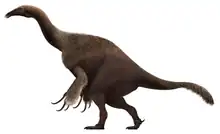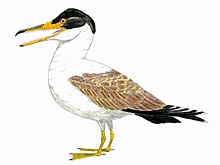| Elsornis Temporal range: Late Cretaceous, | |
|---|---|
| Scientific classification | |
| Domain: | Eukaryota |
| Kingdom: | Animalia |
| Phylum: | Chordata |
| Clade: | Dinosauria |
| Clade: | Saurischia |
| Clade: | Theropoda |
| Clade: | Avialae |
| Clade: | †Enantiornithes |
| Genus: | †Elsornis Chiappe et al., 2007 |
| Species: | †E. keni |
| Binomial name | |
| †Elsornis keni Chiappe et al., 2007 | |
Elsornis is a genus of enantiornithine bird. Only one species is known, Elsornis keni. It lived during the Late Cretaceous. It is known from a partially articulated fossil skeleton found in the Gobi Desert in Mongolia.
The holotype fossil is given catalog number MPD - b 100/201. It is in the collection of the Mongolian Palaeontological Center. The fossil was collected at Togrogiin Shiree, South Gobi Aimak, Mongolia; Djadokhta Formation, Late Cretaceous, Campanian.
The fossil is extremely well preserved in three dimensions. It preserves a pneumatized Furcula, which was a character previously unknown in enantiornithines. Chiappe et al. (2007) conclude from the proportions of Elsornis ' pectoral skeleton that it was flightless or nearly so.[1]
A study by Atterholt et al. in 2018 places Elsornis in the family Avisauridae.[2]
Etymology
The Genus name Elsornis is derived from the Mongolian word "Els", meaning "sand", and "ornis", the Greek word for "bird". The species name "keni" honors Mr. Ken Hayashibara.
References
- ↑ Chiappe, Luis M.; Suzuki, Shigeru; Dyke, Gareth J.; Watabe, Mahito; Tsogtbaatar, K.; Barsbold, Rinchen (2007). "A new Enantiornithine bird from the Late Cretaceous of the Gobi desert". Journal of Systematic Palaeontology. 5 (2): 193–208. Bibcode:2007JSPal...5..193C. doi:10.1017/S1477201906001969. S2CID 85391743.
- ↑ Atterholt, Jessie; Hutchison, J. Howard; O’Connor, Jingmai K. (2018-11-13). "The most complete enantiornithine from North America and a phylogenetic analysis of the Avisauridae". PeerJ. 6: e5910. doi:10.7717/peerj.5910. ISSN 2167-8359. PMC 6238772. PMID 30479894.






.jpg.webp)




